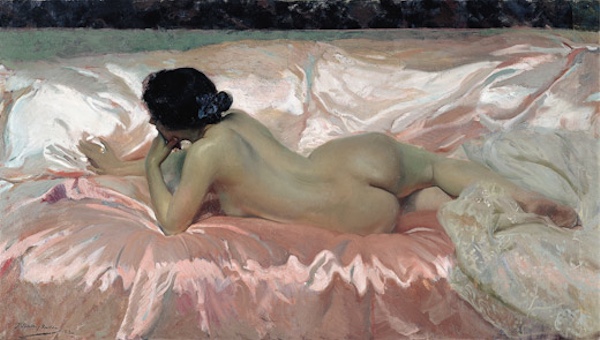

Ya el oro natural crespes o extiendas,
O a componerlo con industria aspires,
Lucir sus lazos o sus ondas mires,
Cuando libre a tus damas lo encomiendas,
O ya, por nueva ley de Amor, lo prendas
Entre ricos diamantes y zafires,
O bajo hermosas plumas lo retires,
Y el traje varonil fingir pretendas,
Búscale Adonis por su Venus, antes
Por su Adonis te tiene ya la diosa,
Y a entrambos los engañan tus cabellos;
Mas yo, en la misma duda milagrosa,
Mientras se hallan en ti los dos amantes,
Muero por ambos y de celos de ellos.
Whether thou curl, or braid thy native gold,
And workst it pliant into every forme,
Or leavst it by thy maids to be unrolled,
Falling about thy neck like Danae’s storme:
Or whether richly ‘tis enameled
With cheerful emeralds, and blue sapphire veins,
Or crowned with tossing plumes, which hide thy head,
Hunting the hart over the shining plains,
Venus mistakes thee for her rural Lover,
Whom late Adonis for his Venus tooke;
Whilst change of dresses doth by turns discover
A lovely swain, and goddess in thy looke.
But I, to whom they both united seeme,
In love with her, grow jealous straight of him.
—Bartolomé Leonardo de Argensola, Ya el oro natural crespes contained in Rimas (1634)(transl. R. Fanshawe, 1650)
On an early morning visit to Madrid’s Museo del Prado a few days ago I made the acquaintance of Joaquín Sorolla, who might be described as Spain’s one-man answer to the French Impressionists. The museum mounted a massive “anthological” exhibition of Sorolla’s works this summer, and it proved an effort that merits the voyage, as the Guide Michelin would say. Some of the things that immediately strike the viewer are Sorolla’s prodigious output, often filling enormous canvases, his masterful treatment of light in paintings, his obsession with the sea and innocent pleasures at the seaside. It seems almost an indulgence: how can a painter create works that are so full of happiness and pleasure—that regale in the human experience of life? Several times before I had passed by Sorolla’s works without paying them much attention, but this collection was enrapturing.
Walking through the exhibition, one work fascinated me: it was a reclining female nude. The technical mastery of the work (which does not reproduce particularly well) is stunning, especially in the luminousness of the soft pink sheets on which the body rests, in the airiness of a piece of gauze thrown over the end of the bed, in the sensuousness of the human torso, her back turned against the viewer as she examines a precious ring, in the graceful curves of her black hair, tied in a rich indigo ribbon. It is an indoor scene, but Sorolla fills it with light surrounding the body—and at the same time manages to focus our attention on that body, which radiates a duller luminosity all its own. This is without a doubt a very great masterwork.
It is also an act of homage to Diego Velázquez, the great Spanish painter of the Golden Age, whose work clearly was a steady inspiration to Sorolla. In the exhibition we see a number of Sorolla’s attempts to copy, perhaps to update, Velázquez, mostly from his student days. But this painting was a clear effort to reconceptualize one of the great Velázquez masterworks, Venus at Her Mirror. The exhibition notes tell us that in 1902, as Sorolla conceives this work, he makes a special trip to London for purposes of viewing the Velázquez work, then in the Rockby Collection (and now at the National Gallery). He writes a postcard from the showing. “Velázquez magnificent,” he writes, “but Venus has too much clutter.” But in his reclining nude of 1902, we see how Sorolla recasts his Venus. First, indeed, he has dispensed with the clutter—gone is the mirror and its supporting cupid. Instead, Sorolla’s Venus is fixed on a ring—which takes the place of the vanitas theme provided by the mirror without the distracting complexity of the reflected view. The draping and sheets in Sorolla’s paintings are much lighter, and indeed Sorolla uses the sheen of the silk as a light source in which to envelope his nude. But Sorolla’s treatment of the skin, his exceptional colorations, the subtle use of blueish-gray shadows in the small of the back and around the fingers, the luminousness of the left shoulder and right hip all combine to present an astonishingly life-like figure, especially when compared with Velázquez. These are two very great works, still it is hard not to see Sorolla’s as the more immediately appealing, elegant and voluptuous. It may come as something of a surprise to learn that this loving, sensuous portrait is of Sorolla’s wife Clotilde, then the mother of three and approaching forty years in age.
It seems to me that we could use these two works—and one that falls between them, namely the Maja of Goya—to describe the trajectory of Spanish allegorical portraiture from the Golden Age to the Twentieth Century. They treat a subject which could in the time of Velázquez and Goya be approached only with great caution because of the disapproval of the Holy Office—this explains why Velázquez turns his female nude away and portrays her as a figure from Greek mythology and why Goya’s painting was so carefully shielded. (It’s curious by the way that the clothed Maja is a far better painting in terms of technical execution than the nude.) By the time of Sorolla artistic freedom was much greater, of course, but he finds advantage in the more modest posing of Velázquez over the fully revealed lounging Maja.
Listen to Julian Bream perform Enrique Granados’s La Maja de Goya from Tonadillos (1910):



